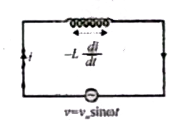An a.c. voltage v=vmsinωt is applied across an inductance L . Show that in an inductance, voltage leads the current by 90∘ or π2
Let us consider that an alternating e.m.f. v=vmsinωt is applied to a pure inductor of inductance l. The circuit diagram is shown in the following figure
v=vmsinωt . . . (i)
If I is current in the circuit then
Induced e.m.f. v=LdidtandvL=didt,di=vLdt
Integrating both sides, we get ∫di=lL∫vdt
or i=lL∫vdt . . . (ii)
substituting v=vmsinωt in equation (i)
i=lL∫vmsinωtdt=vmL−cosωtω
i=vmωLsin(ωt−π2)
i=imsin(ωt−π2) . . . (iii)
Where im=vmωL
Comparing eqn. (i) and (iii) , there is phase difference of π/2 . Hence current tags behind the e.m.f. by an angle of π/2

Similar Questions
An a.c. voltage V=Vm sin ot is applied across an inductor L. Obtain an expression for current I.
View SolutionExplain the term 'inductive reactance'.Show graphically the variation of inductive reactance with frequency of the applied alternating voltage.
An a.c. voltage E=E0sinωt is applied across a pure inductor L.Show mathematically that the current flowing through it lags behind the applied voltage by a phase angle of π/2.
View Solution
Knowledge Check
If an alternating voltage V=V_0 sin omegat is applied across an inductance I, the current through the inductance will be
AI=I0sinωtBI=I0sin(ωt+π/2)CI=I0sin(ωt+π/2)DI=I0sin(ωt+π)If an alternating voltage V=V_0 sin omegat is applied across an inductance I, the current through the inductance will be
AI=I0sinωtBI=I0sin(ωt+π/2)CI=I0sin(ωt+π/2)DI=I0sin(ωt+π)A sinusoidal voltage V(t) = 100 sin (500t) is applied across a pure inductance of L = 0.02 H. the current through the coil is
A10 cos (500t).B−10 cos (500t).C10 sin (500t)D−10 sin (500t)
Explain the term 'inductive reactance'.Show graphically the variation of inductive reactance with frequency of the applied alternating voltage.
An a.c. voltage E=E0sinωt is applied across a pure inductor L.Show mathematically that the current flowing through it lags behind the applied voltage by a phase angle of π/2.
View SolutionExplain the term 'capacitive reactance'.Show graphically the variation of capacitive reactance with frequency of the applied alternating voltage.
An a.c. voltage E=E0sinωt is applied a across a pure capacitor C.Show mathematically that the current flowing through it leads the applied voltage by a phase angle of π/2
View SolutionExplain the term 'capacitive reactance'.Show graphically the variation of capacitive reactance with frequency of the applied alternating voltage.
An a.c. voltage E=E0sinωt is applied a across a pure capacitor C.Show mathematically that the current flowing through it leads the applied voltage by a phase angle of π/2
View SolutionIn a circuit containing an inductance of zero resistances, the e.m.f of the applied AC voltage leads the current by
View SolutionA sinusoidal voltage V(t)=100sin(500t) is applied across a pure inductance of L=0.02H. The current through the coil is :
View Solution
